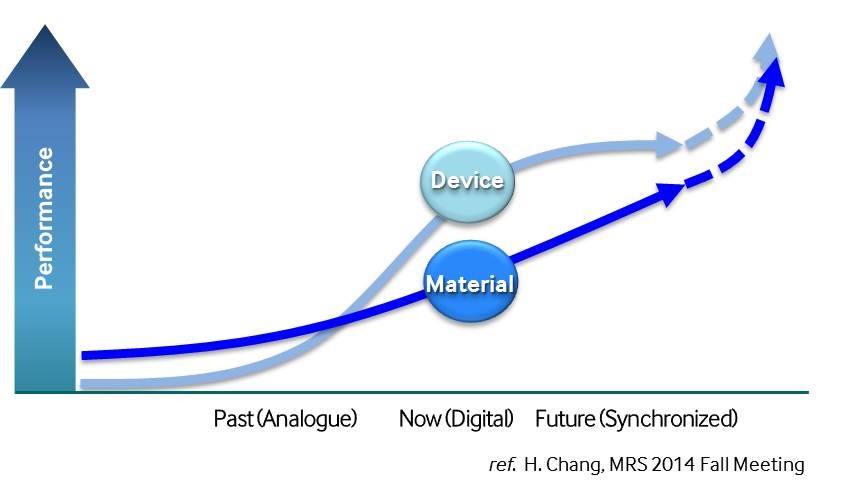Synchronization of Materials Research and Device Development Key to Innovation

Recent innovations in materials science have led to a boom in the creation of new devices, allowing for a rapid shift from analogue to digital in a relatively short amount of time.
In the past, materials were researched, developed and perfected long before they were applied to devices. Take liquid crystals, for example. They were first discovered in the late 1800s, and for decades were studied and defined in the academic realm. It wasn’t until the 1960s―almost a century later―that they were utilized in commercial products. Similarly, it took 30 years after its invention for lithium metal oxide to even be tested in batteries, and another decade before it made its official commercial market introduction.
Once materials such as these were introduced, however, they allowed for a steady and fairly rapid increase in device performance. In the display industry specifically, there has been enormous growth in the market because of such advancements up until now.
However, as the market becomes increasingly saturated, electronic materials innovations are beginning to fall behind the device revolution. This is mostly due to the fact that the device product life cycle is becoming much faster than that of the material. Now, the device itself is facing the limitations of this revolution in terms of product performance and functionality without the aid of novel materials.
To ensure consistent advancements and optimum functionality, both materials and devices have to be synchronized throughout the development process from the earliest stages of research so that performance requirements can be properly understood.
This was the message of the plenary session led by Dr. Hyuk Chang, Executive Vice President , Samsung Advanced Institute of Technology (SAIT), at the 9th International Conference on Quantum Dots held earlier this month.
Chang noted that the synchronization of materials research and device development can accelerate the enhancement of both the devices and the materials that they are made of, thus revitalizing the market.
“After all, innovation comes in many forms, and source technology is a foundational one,” Chang said.

The speeds of material and device innovation have changed over time. SAIT now aims to synchronize the two.
At Samsung, there are numerous organizations that carry out research and development. These include SAIT, where the company pioneers long-term, radical researches with five to ten year or more horizons; the R&D centers that explore next-generation products and platform technologies one to three years in advance; and business unit development teams that focus on commercialization, applying these latest technologies in product development.
Samsung is increasingly synchronizing its R&D efforts to bring core technologies like new materials to products more quickly.
One example is quantum dot technology. Confident that this specific technology could ultimately drive the future of display, among other areas, Samsung has researched the material and its advantages in earnest. In fact, researchers at SAIT started focusing on quantum dot technology over a decade ago, and have since registered numerous patents on the subject.
Through constant testing, evaluating and verifying the material from the earliest stages of device design, Samsung was able to incorporate quantum dots to create a revolutionary line-up of products―its 2015 SUHD TVs.

Example of a synchronized research roadmap
In doing so, the technology allowed for highly accurate color expression and better, brighter picture quality while improving overall energy efficiency at a lower cost―all with cadmium-free quantum dots. Considering that this was the first commercial application of the material, it created quite a buzz among academics in the field who had been eagerly anticipating such a milestone.
Despite these accomplishments, Samsung wanted to improve upon this technology and did so with its 2016 SUHD TVs, making them even more energy-efficient, and allowing them to display the picture quality more accurately.
“As a materials scientist, my previous work was in small-scale labs,” Chang explained. “It was overwhelming to see this technology make its way to mass production and even hit center stage at the industry’s top events like CES in just a decade. That’s the speed and scale of Samsung.”
As Samsung continues to research and refine the technology, the company predicts that quantum dots will further enhance display devices.
Chang noted that quantum dots could be applied in other ways, too, such as to improve the accuracy of image sensors, which could significantly advance autonomous cars. Experts note that the technology also has great potential in the areas of chemo- and bio-sensing. In fact, researchers at SAIT have already begun to utilize quantum dot technology in these areas, and are eager to continue to progress these developments.
“Just as Samsung’s SUHD TVs were realized by evolutionary quantum dot materials and boundless research for discovering novel physical phenomena, functional materials, value-added materials and next-generation devices must be closely interconnected,” Chang stated.
This, he believes, will accelerate materials innovations, leading to new functionalities in devices and the creation of novel devices. The synchronization of materials research and device development will also help to breathe new life into the massive global materials marketplace. By consistently providing added value with new materials, Samsung hopes to continue to revitalize the electronic devices industry.
* Last week in Jeju City, Korea, top scholars from around the world came together to share the latest on quantum dot research at the 9th International Conference on Quantum Dots. Samsung, being the first in the world to commercialize cadmium-free quantum dot technology with its SUHD TVs, also took part, sharing its experiences in quantum dot research. This article is the second of a three-part series that highlights recent advancements in quantum dot technology.
** No official decisions have been made regarding the future application of the technologies and projects mentioned in this article.